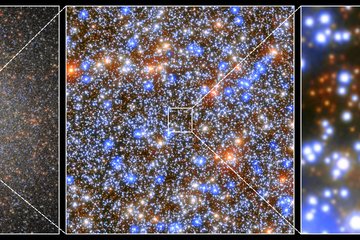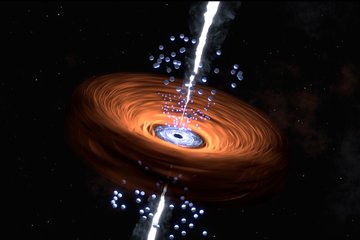New method finds black hole closest to Earth
The finding promises numerous similar discoveries
Using data from ESA’s Gaia astrometry mission, astronomers have identified the closest known black hole, less than 1600 light-years away from Earth, and determined its mass. The black hole is orbited by a star similar to our Sun, and was identified by tracking the star that the black hole is orbiting. It is expected to be the first one of many black holes to be discovered using the same method. At the same time, the properties of the binary star system are unexpected, indicating a serious gap in astronomers’ understanding of how such systems form in the first place. The article has been accepted for publication in the Monthly Notices of the Royal Astronomical Society.

see star and black hole up close.
Black holes are difficult to observe, by their definition: mass concentrated in a region with a diameter so small that the resulting extremely strong gravity allows nothing to escape, not even light. Still, these objects have long found their place in astrophysics. So-called stellar black holes, in particular, with a few solar masses, are the end state of very massive stars. Now, a group of astronomers led by Kareem El-Badry (Max Planck Institute for Astronomy [MPIA] and Harvard-Smithsonian Center for Astrophysics) has used a novel method to discover the closest known black hole. The discovery also shows up gaps in current astronomical knowledge, namely about the formation of binary star systems.
Finding stellar black holes
There are an estimated hundred million stellar black holes in our home galaxy, the Milky Way, but only a small fraction has been detected so far. Some have been detected by gravitational wave detectors, which have measured almost a hundred mergers of stellar black holes, yielding additional data about black hole masses.
Of those few dozen stellar black holes that have been detected using telescope observations, most orbit a companion star closely enough for the black hole’s gravity to pull hydrogen gas from the companion star into a so-called accretion disk that surrounds the black hole. The gas then becomes hot enough in the process to emit considerable amounts of X-rays. There are 20 known “X-ray binaries” of this kind, with an additional 50 candidate objects.
The difficulties of detecting quiescent stellar black holes
There have been several attempts to also find “quiescent” black holes in binary systems – black holes without an X-ray-emitting disk. The tool of choice: stellar spectra, the rainbow-like decomposition of star light, which contain information about a star's motion. We know this, from everyday life, from the “Doppler effect” for sound: an ambulance with a blaring siren will sound higher-pitched when it is coming towards us, and lower-pitched once it has passed us. Similarly, light in stellar spectra tell us about a star’s motion directly towards us or away from us.
Over the past few years, there have been several claims of quiescent black hole discoveries that tried to deduce a binary’s orbit and the mass of an unseen companion exclusively from stellar spectra. However, all but one of them (the June 2022 discovery of the binary system VFTS 243, with El-Badry as co-author) have since been challenged or downright refuted by follow-up studies. The key problem: Spectra give only part of the information about stellar motion, and hence about the orbit and about the companion’s mass. The missing information is a fundamental source of uncertainty – and it’s also where ESA’s Gaia mission promises help!
Gaia provides the extra data
For a few years now, there has been hope that ESA’s astrometry mission Gaia would open up a new way of detecting and characterizing black holes in binary star systems by providing information that is complementary to what stellar spectra deliver. Gaia is designed for ultra-precise measurements of stellar position. This includes the ability to detect a visible star's motion on the sky, and from that to deduce the presence of an unseen companion.
This kind of binary containing a black hole would still be very rare, compared to the overall number of binaries. That is why, in this case, Gaia’s scope is just as important as the survey’s accuracy: high-quality data for more than a hundred thousand binary systems makes for a fair chance to find the needle in the haystack, the black hole binary among the many ordinary binaries.
Searching Gaia data for black hole binary candidates
When Gaia’s data release 3 (Gaia DR3), the first to contain the orbital data for binary systems detected with Gaia, was published in mid-June 2022, Kareem El-Badry, together with MPIA director Hans-Walter Rix and their colleagues directly set about sifting the data for likely candidates. Generally, as two objects in a binary system orbit each other, they each trace out a tiny ellipse in the sky. Gaia DR3 contains data for 168,065 such tiny ellipses, or parts thereof.
Applying selection criteria that were particularly likely to pick out systems in which a luminous star is dragged around by an invisible companion with considerable mass, the researchers narrowed their set down to six possible candidates. All six candidates warranted a closer look: with the help of the complementary information of radial velocity measurements derived from the star’s spectrum, giving information about motion directly towards us or away from us.
Narrowing the field
The fact that radial velocities and Gaia positions are two sides of the same coin, so to speak, enables crucial consistency checks. Using existing spectral data available in astronomical archives, the astronomers were able to rule out three of the candidates right away. In those cases, the available radial velocity data flatly contradicted the Gaia reconstruction of the binary orbit.
Another candidate could be ruled out by the bad fit of the Gaia data to the reconstructed orbit, with an orbital period so long that Gaia should not have been able to measure it in the first place. A fifth candidate is still under consideration, awaiting additional spectral measurements.
Gaia BH1: the closest known black hole
The remaining candidate, Gaia DR3 4373465352415301632, which the researchers have dubbed “Gaia BH1”, fit the bill very well: all the available data were consistent. For added certainty, the astronomers also performed additional targeted observations of Gaia BH1: with the 6.5 m Magellan Clay telescope, the 8.1 m Gemini-North telescope, the 10 m Keck I telescope and, for the lion's share of the new data points, the 2.2m ESO/MPG telescope that MPIA operates at ESO's La Silla observatory.
The orbital reconstruction held up. Gaia BH1 was a system with an invisible object with a mass of about 10 solar masses, which formed a binary system together with a star very similar to our own Sun. The two objects orbit each other once every 185.6 days. The distance between star and companion is about the same as the average Earth-Sun distance. If the 10-solar-mass-object were another star, it would necessarily be much brighter than its companion. Instead, neither Gaia nor follow-up observations show any trace of a second star.
An excellent black hole candidate
This makes Gaia BH1 an excellent candidate for a black hole – and at a distance of around 1560 light-years, by far the black hole closest to Earth that astronomers have yet found, less than half the distance of the previous record-holder!
Gaia data was crucial for the new discovery. El-Badry goes so far as to say: “Hundreds of researchers worked to produce the data products we used to find the black hole Gaia BH1. This discovery belongs not just to us, but to the Gaia collaboration.”
Statistically speaking, the closeness implies that there should be numerous similar systems throughout the galaxy. Putting a number to the “numerous” is hard, though. But El-Badry and his colleagues have a fairly good estimate that the next big Gaia data release, DR4, currently expected not before the end of 2025, should allow for the discovery of dozens of similar systems.
The end of a long search
Looking back on the discovery, Kareem El-Badry says: “I have been searching for a system like Gaia BH1 for the last four years, trying all kinds of methods – but none of them worked. It has been elating to see this search finally bear fruit.”
El-Badry adds: “Part of the reason this project is exciting is that we truly did not know our chances of finding something at all: theoretical predictions differed by many orders of magnitude. Having one object to analyze is a major upgrade from zero, and we now need to work to learn everything we can from it, while also preparing for a larger sample in future Gaia data releases.”
...but how did it form?
Gaia BH1 is a spectacular find, but also a puzzling one. It is difficult to explain how a system like this could have formed in the first place. Specifically, the progenitor star that later turned into a black hole would be expected to have had a mass of at least 20 solar masses, which means its lifetime would have been very short – on the order of a few million years. If both stars formed at the same time, this massive star would have turned into a supergiant, puffing up and engulfing space to far beyond the stars' common orbit, before the other star would have even had the time to become a proper, hydrogen-burning (“main sequence”) star.
It is not at all clear how the solar-mass star could have survived that episode, ending up as apparently normal as the observations of the black hole binary indicate. Theoretical models that do allow for survival all predict that the solar-mass star should have ended up on a much tighter orbit than what is actually observed.
Star cluster dynamics or a triple system?
This leaves more unusual formation scenarios. For instance, the two original stars could have formed as part of a star cluster. Initially, they would have been considerably farther apart, so the massive star's supergiant phase would not have disturbed the solar-mass star’s evolution. Close encounters of the system with additional stars in the cluster could later have changed the orbit to its present much smaller size.
Alternatively, the system could in fact have not two, but three components: Two massive stars instead of one, in close orbit with each other, and the one-solar-mass star orbiting the massive pair at a greater distance. The two massive stars would prevent each other from turning into supergiants. In that case, the 10-solar-mass object might not be a single black hole, but a pair of black holes in close orbit around each other. Since that orbiting pair would exert slightly different gravitational forces on the one-solar-mass star, precise future observations might confirm or rule out that possibility.
All in all, Gaia BH1 is at least three things in one: It is an exciting discovery of the closest known black hole, less than half as far than any black hole detected previously. It is a promise of future similar discoveries to come within the next few years, but also a sobering reminder of the limits of current astronomical knowledge about the formation of binary or, more generally, multiple star systems.
Background information
The research described here is accepted for publication as Kareem El-Badry et al., “A Sun-like star orbiting a black hole”, in the Monthly Notices of the Royal Astronomical Society.
The MPIA researchers involved are Kareem El-Badry (also Harvard-Smithsonian Center for Astrophysics and Harvard Society of Fellows), Hans-Walter Rix, Rhys Seeburger, Silvia Almada Monter and Jennifer Wojno.
MP/MN









